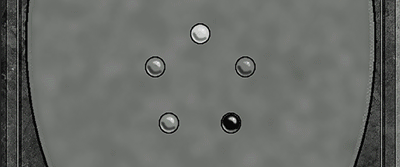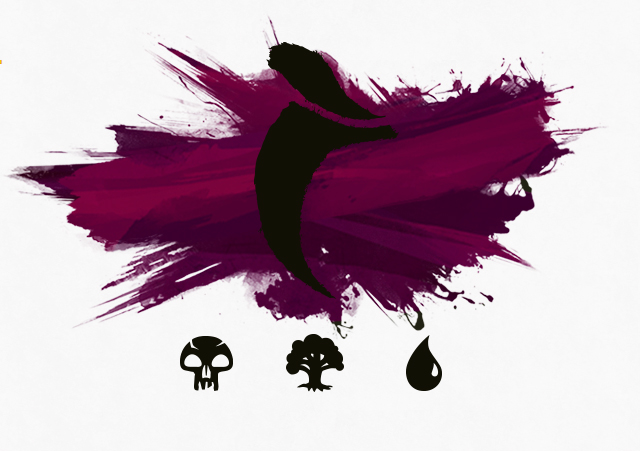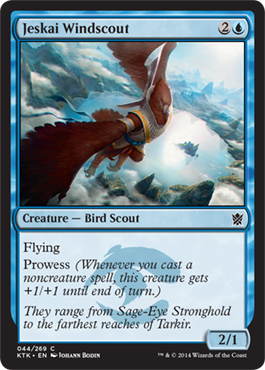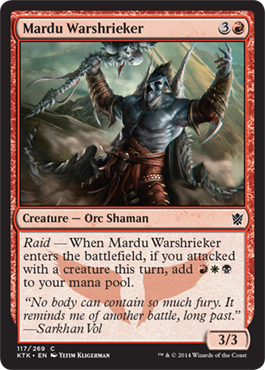Khans of Tarkir Prerelease Primer
Welcome to Tarkir, Planeswalker.

Tarkir is filled by members of five ancestral clans. Locked in war with each other, they always welcome new recruits—and now, the door to join one of the clans is open for you. Which of the five clan banners will you choose to raise
There's a big choice to make about which clan to align yourself with—and, of course, you wouldn't want to head out into the wilds of Tarkir without first knowing a bit about each clan and what you're up against! That's where I come in. It's dangerous out there—and this article is meant to help make your time on Tarkir a pleasant (and victorious) one.
And where better to start your journey on Tarkir than the Prerelease?
Khanquering the Prerelease
Ah, Prereleases.
Prereleases are some of my favorite tournaments of them all—and the large set at the start of a block is the perfect time to show up! Everything is brand new to everyone playing, and you can all experience the set for the first time.
A Prerelease was the first major event I ever went to back when I was eleven years old, and even today, a Prerelease still makes me as excited as I was then. It's your first chance to play with the new cards before anybody else and get an edge over all your friends. And, since in this case it's brand new, it's an even playing field; people haven't dissected this format for weeks to figure out the optimal strategy. And most of all, it's a low-key, more casual event that's just a lot of fun!
If you're a Sealed Deck veteran, you may want to skip ahead to the next section, where I talk about some of the differences and special pieces you can expect at your local store for Khans of Tarkir . But if you're new to this whole crazy Sealed Deck shindig, or are maybe just looking for a few extra pointers, then read on!
Okay. So step one is you actually have to get to one of these mysterious "Prerelease" thingies (that's the technical term) in the first place.
If you don't already have a local shop you frequent, be sure to check out the store locator to find one near you! That store may even offer preregistration. Prereleases are one of the most popular events we put on, so be sure to check and see if they preregister. The best time to find out an event is full is decidedly not when you show up and learn you can't play, so be sure to look ahead.

Okay. Great. You've found your store—excellent!
As you travel to a brand-new plane, you're going to want to make sure your Planeswalker backpack has everything you'll need for the adventure! While you will be building your deck for the event with cards you're given when you get there, there's plenty to do beside just that.
For example, you may still want to bring a deck to play between rounds for fun, a trade binder, pen and paper to keep track of life, and even a water bottle plus a few granola bars to snack on. There are no dragons on Tarkir, so if dragon meat is your preferred meal of choice, make sure to pack some, because the locals won't have any! You can expect a Prerelease event to take about four or five hours, so come prepared.
Okay, let's see. You have a store and you've packed your trusty bag with all of the essentials (and potentially dragon meat) for a day out in the uncharted and competitive wilds of Tarkir. Great! That means it's time for...
Khancepting Your Deck
Khans of Tarkir is a little different than anything we've ever done in Magic : it is a set focused around clans, each of which encompasses three "wedge" colors. A wedge means two "allied" colors and one "enemy" color.

Each clan stands for something and has its own awesome ability that only it gets (which I'll get into a little bit later) but the first choice you have to make is which clan you want to align yourself with. You will be handed a box that contained everything you need to make a deck, which includes a special booster pack full of cards that help you play a clan deck!
Not sure which clan is for you? Well, here's a quick guide:

Abzan
The weathered warriors of Abzan are known for their endurance. Their creatures get bigger over time thanks to the outlast ability—hold down the early game, and your Abzan legion can take over the long game!

Jeskai
The nimble monks and enlightened students of cunning outdo their opponents through wit in combat. The prowess ability threatens that their creatures grow out of nowhere in combat, making each opponent think twice before tangling with a Jeskai warrior.

Mardu
The Mardu clan embodies the speed of the dragon, and these bloodthirsty warriors tend to be just that in the game of Magic ! Fast, brutal, and unrelenting, many Mardu cards have raid—which gives you an additional bonus if you attacked this turn—and since you're Mardu, of course you did!

Sultai
The Sultai clan deals in opulence and wealth—but make no mistake, for it is ruthless. Using the dead as a resource, the Sultai harness the delve mechanic to play their huge threats far earlier than they otherwise would.

Temur
The Temur clan fights with savagery. Full of huge creatures, the Temur clan's mechanic of ferocious rewards you for having a creature with power 4 or greater on the battlefield—making your big threats even more dangerous.
Still not sure which clan is for you? Take the clan quiz!
All right, now that you have a clan in mind you can make your choice! Sign up, tell your tournament organizer your clan, and you'll be handed a cool-looking clan box. Inside this box you'll find several things, but most key to actually helping you play at a Prerelease will be your various booster packs! (Five regular Khans of Tarkir boosters plus one rather special clan booster—but I'll get to that in a moment.)
Rip those packs open and you'll be left with a stack of cards. So, what now? Well, it's time to build a deck!
Sealed Deck is a little different from normal deck building. You get to build a deck only out of the cards in front of you, plus as many basic lands as you'd like. Also, unlike a normal Constructed deck where the minimum deck size is 60, you only have to play 40 cards.
Deck building in a world with so many multicolored cards can be tricky—and this is where that special clan booster comes in.
When you picked your box you chose a specific clan, and that clan matches up with the contents of your special "seed booster" that was wrapped in plastic as you opened your box. This "seeded deck" experience helps you figure out what colors to play. That pack contains cards only in your chosen clan's colors—meaning that's a pretty safe bet for working in your deck.
While you are allowed to play any colors you want, most often it's going to be advantageous to play your clan's colors. So, what I would recommend is to just set aside all of the cards of the other two colors your clan doesn't have and pick the best cards in your clan. If there's a really cool rare or strong card in another color you want to play, set it aside and come back to it later, since you could consider "splashing" it if you have the right mana-fixing lands, but in general you'll want to put cards of other colors away here.
All right, so how do you narrow down all of your clan's cards down to the 22–23 cards you're going to want to put in your deck? It's time to lay them out!
Take the cards of your clan's colors and lay the creatures out in mana cost order, like this:
Take the cards of your clan's colors and lay the creatures out in mana cost order, like the example below (using cards from Magic 2015 ) when you click the Stats tab:
[Decklist]
Title: Creature Mana Curve
Format:
Commander:
1 Cruel Sadist
1 Ajani's Pridemate
1 Black Cat
1 Kinsbaile Skirmisher
1 Oreskos Swiftclaw
1 Satyr Wayfinder
1 Walking Corpse
1 Carrion Crow
1 Geist of the Moors
1 Heliod's Pilgrim
1 Hornet Nest
1 Hushwing Gryff
1 Midnight Guard
1 Preeminent Captain
1 Reclamation Sage
1 Xathrid Slyblade
1 Accursed Spirit
1 Gravedigger
1 Paragon of Eternal Wilds
1 Paragon of New Dawns
1 Razorfoot Griffin
1 Roaring Primadox
1 Shaman of Spring
1 Avacyn, Guardian Angel
1 Blood Host
1 Charging Rhino
1 Indulgent Tormentor
1 Rotfeaster Maggot
1 Serra Angel
1 Shadowcloak Vampire
1 Kalonian Twingrove
1 Ob Nixilis, Unshackled
1 Phytotitan
1 Soul of Theros
[/decklist]
A good "mana curve" of creatures is crucial to a good Sealed Deck. You don't want to have a ton of cards at any single spot in the curve: it's important for you to be able to have a mix so you can play your cheap spells in the early game and your expensive spells in the late game. As a very general rule for limited, I would look to play something like this:
2 mana: 4–6 creatures
3 mana: 3–5 creatures
4 mana: 4 creatures
5 mana: 3 creatures
6+ mana: 1–2 creatures
______________________
Total Creatures: 15-22, but aim for around 18
That's far from hard and fast, but it's a good place to start. Cull your creatures down to these numbers by choosing your favorites. (Or choosing them based off of which ones have names that most sound like good rock songs. In this set, I wouldn't blame you.)
Something else to keep in mind is that sometimes it will be correct to play two colors of your clan and splash the third, meaning you are primarily two colors and playing some of your stronger cards of the third color. (Including your three-color cards.) If, while paring down your creatures, you notice you only have a few cards of one color left, consider splashing that color instead.
Now that you have your core creature base figured out, it's time to add in spells! Pick your favorites among your colors to bring your deck to 22 or 23 cards, and then you're good to go from the spell side!
The last thing to figure out is your mana base! In a three-color set, making sure you can cast your spells is important. I would definitely play all of your nonbasic lands that produce mana of your colors. Even if they enter the battlefield tapped, it is a small price to pay for making sure you can play your cards on time! Generally, you will have two colors in your deck that have a lot of the lower-mana cards, and you'll want to play more mana-producing lands of those colors than of the cards with the more expensive mana costs to ensure you can play your cheap cards on time.
Interested in more tips? Here are a few more things to keep in mind for deck building:
- You can play more than 40 cards, but you really should stick to 40 if you can. Every card over 40 you play just means it's that much less likely you're going to draw that awesome rare you put in your deck!
- The land ratio you're looking at should be about 17 lands to 23 nonlands. This isn't right 100% of the time, but most Limited decks end up looking like this and, in general, it's what I would want to have.
- Play a mix of cheap-to-cast and expensive-to-cast cards. If you have all cheap, small creatures then a single big creature can shut you down, but if you have all expensive, large creatures you risk getting run over first. Stick to a mix that focuses on the two-, three-, four-, and five-casting cost creatures. More games of Sealed Deck are won by casting a creature every turn starting on turn two or three than any other way.
- Evasion is important! Often, Sealed Deck games will get into stalls where both players have a lot of creatures and neither player can attack very well. Creatures with abilities like flying ensure that you can break through these creature stalls.
If you want to dive really deep into Sealed, here are a few articles you can check out to learn even more:
- "Sealed Deck"
- "How I Break Down My Sealed Pool"
- "Prerelease Prerogatives"
- "Sealed Deck Reality Check"
- "Foundations"
- Nate Price's Price of Progress series
- "Prerelease Primer"
Two-Headed Giant
Some stores also support a version of Sealed Deck called Two-Headed Giant (often abbreviated "2HG"), where two players team up against other pairs of players. Each pair gets two Prerelease Packs (they don't have to be the same ones, even; you can figure out which two clans go well together—or double up on the same clan!) from which the players build their decks. Your tournament organizer can tell you more about 2HG if your store supports it.

Dragon-Style Twins | Art by Wesley Burt
Open Dueling
If the idea of spending a day playing a tournament scares you, or you just want to experience more games with Khans of Tarkir , you can get involved in Open Dueling.
In this side event, you get a ready-to-play 60-card Intro Pack and use it to do battle against others participating in Open Dueling, including players participating in the main tournament who are between rounds! This is a great way to dip your toe into the water if you aren't sure the Prerelease is something you want to do, or if you can't commit five hours to a Prerelease event; you can just play games in Open Dueling at your own leisure. Plus, it's fun!
Khancealed Goodies
Starting at the Khans of Tarkir Prerelease, we're doing something a little different with the way we handle your special Prerelease promo card.
In the past, everybody who chose the same box received the same Prerelease card inside. While this was great to ensure everyone had an awesome rare, it had the downside of sometimes making Prerelease games feel the same after a while.
Khans changes that up.
Instead of everybody who chooses the same clan getting the same Prerelease rare, instead there is a subset of eight different foil Prerelease rares per clan that you could receive. You'll still get a take-away card from the event that's stamped with the date—but it'll feel a bit more unique than the old Prerelease cards.
I'm not going to tell you what they all are, but rest assured there are small creatures, big creatures, and spells alike. Oh, and every clan has the chance to open up its clan leader as its Prerelease card! As far as what the other seven are, head to a Prerelease and see what you get firsthand.
Of course, not everything is different.
Inside your box you still get a cool Khans of Tarkir Spindown™ life counter, and there's also an achievement card for each clan:

But there's something else special about these achievement cards:

Well, that means it's time to talk about...
Khantest of Champions
In Khans of Tarkir , there's a fun little activity included inside each Prerelease box that allows you to make a permanent mark in support of your clan.
Each store has five banners, one for each clan. They look something like this:

Cool enough—but to make it even more awesome, you have the opportunity to adorn the banners with your mark of victory. Inside each Prerelease box is a sticker that looks like this:

You get to write your name on it and put it onto your clan's banner! How do you begin this festooning process?
Well, first you need to complete seven of your clan's achievements. Pay attention during gameplay to check these off.
Once you've completed enough, it's time to put up your sticker! Sign it, put it on the banner, and leave it as a display to all who enter the store of you and your clan's fighting prowess. Congratulations! You're instantly famous. People will tell stories of you for generations...or at least occasionally see your name on a banner hanging up in your store.
Khanfused by Abilities?
Khans of Tarkir features a whopping five new mechanics (and one tricky old favorite!) so there's a lot to take in. Fortunately, that's what this section is for! Let's briefly go over them, one by one, courtesy of the "Mechanics of Khans of Tarkir" article:
Outlast
Outlast is an activated ability. When an outlast ability resolves, put a +1/+1 counter on the creature.

Prowess
Prowess is a triggered ability. Prowess triggers whenever you cast a noncreature spell. When prowess resolves, the creature gets +1/+1 until end of turn.

Delve
Spells with delve are very powerful, but usually have a high mana cost. As you're paying for the spell, you can exile cards from your graveyard. Each card you exile this way pays for 1 . Delve can't pay for any colored mana in the spell's mana cost. Also, you can't exile more cards than the amount of colorless mana in the mana cost.

Raid
Raid is an ability word. Raid abilities care only that you've attacked with a creature. Each raid ability is different, so read each carefully to determine what it does.

Ferocious
Ferocious is an ability word that highlights abilities that care about you controlling a creature with power 4 or greater. Each ferocious ability is different, but they all rely in some way on controlling a creature with power 4 or greater.

Morph
Morph is a returning mechanic that lets you cast spells as face-down creatures. A face-down creature spell is a 2/2 colorless creature spell with no name, no creature types, no abilities, and no mana cost. Instead of paying its mana cost (which it doesn't have), you pay 3 . If the spell resolves, put the card face-down onto the battlefield, where it will have those same characteristics instead of its normal ones. You can always cast a creature card with morph face up by paying its mana cost as normal.

Khanfidence in Your Victory
Now that you've read through this article, you are armed with everything you will need for your sojourn to Tarkir. The Prerelease is this weekend—so go out to your local store, choose your clan, and have a blast!
Looking for even more ways to support your clan outside of the Prerelease? Don't forget to choose your clan on PlaneswalkerPoints.com so you can support them on the clan leaderboard. Additionally, the highest-finishing FNM finishers of each clan each week will have the opportunity to make their marks on the store by writing their name on a banner, so don't miss out on that chance to make yourself known as well.
Oh, and one last thing: if you're curious about all of the awesome cards in Khans of Tarkir , the entire set is now available in the Card Image Gallery!
Otherwise, if you have any questions at all, feel free to send me a tweet or ask me a question on my Tumblr and I'd be happy to help however I can. Whether you're looking for some more tips on Sealed Deck or just want advice on which clan you should choose (I'll give you a hint: I'm known around the office as "Captain Abzan") I can help answer your questions.
Go out, enjoy exploring Tarkir, and may you avoid crossing paths with Sarkhan—at least on the other side of the table.
Have fun this weekend!
Gavin

